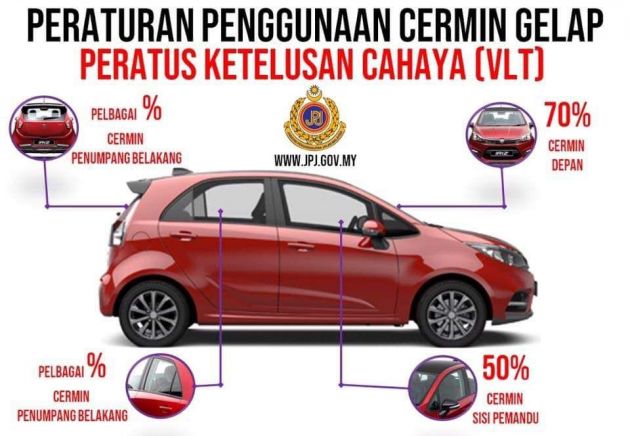In 2019, the government announced revisions to the vehicle tinting guideline, updating it from that previously amended in February 2016. when updated regulations filed under Motor Vehicles (Prohibition of Certain Types of Glass) (Amendment) Rules 2016 replaced the previous 1991 rules.
Current regulations as stipulated under the 2019 revision are a minimum visible light transmission (VLT) percentage of 70% for the front windscreen, 50% for the front side windows, and unlimited (0%) for the rear windows and rear windscreen. The latter is allowed provided there are two side mirrors (as in left and right) attached to the vehicle.
The road transport department (JPJ) has reminded motorists about adhering to these regulations, saying that motorists found not complying with them face a fine of RM2,000 or a jail term not exceeding six months for the first offence. For a second offence, the fine will be increased to RM4,000 or a jail term not exceeding 12 months, or both.
In a statement, the department said that it had issued 108,428 notices for window tint offences since 2019, and that 17,218 summonses were issued under JPJ(P)22 for offences involving illegal window tint.
The department added that the public can help it take action against offenders by furnishing details or images of vehicles not complying to these rules via e-Aduan@JPJ on the MyJPJ application.
Looking to sell your car? Sell it with Carro.












AI-generated Summary ✨
The comments mainly discuss frustrations and opinions about JPJ's window tint enforcement, with many feeling the penalties and rules are excessive or unfair, especially for lighter tints on rear windows, and some suggest the enforcement is inconsistent or biased. Several criticize the focus on petty violations instead of addressing more critical traffic issues like congestion and noise pollution. There are concerns about the use of dark tints by criminals and scammers hiding inside cars, but many respondents argue that consumers demand darker films and enforcement should target shops and illegal tinting activities. Some express skepticism about the effectiveness of fines and enforcement, accusing authorities of laziness or misconduct, and there are calls for fair implementation of regulations and more practical solutions. Overall, sentiments reflect annoyance, skepticism, and disagreement with current tint policies.